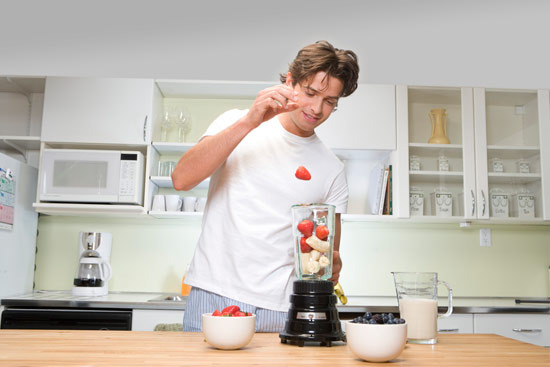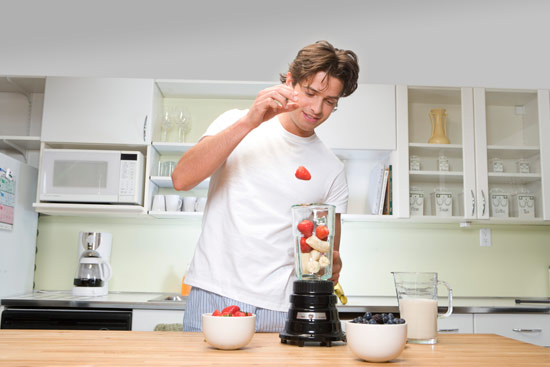How To Make A Smoothie
Learning how to make a smoothie that's delicious, healthful, and gentle on your blender is easy, and we're going to show you how to bring tasty smoothie joy to your kitchen in 10 simple steps. Once you learn to build a smoothie, you can start developing great, healthful smoothie recipes, filled with nutritious vegetables, fruits, and protein sources. Start with our smoothie recipes like the Banana Smoothie Recipe, Strawberry Smoothie Recipe, and the Tropical Smoothie Recipe, and move on to your own personalized variations.
Smoothies are a great way to get some extra green in your diet, but all that kale and spinach can taste really bitter. Read more about How to Make Kale Smoothies You Actually Want to Drink for tips on how to transform those tough green leaves into sweet treats.
You don't have to use all of these ingredients all the time — some great smoothies can be made with just liquids and frozen fruit — but whether you're going to leave any ingredients out, make sure you combine them in the order outlined below. Ingredients should go in your blender in a particular order so as to prevent wear and tear on the blender's blades and motor.
The Daily Meal's 10-Step Smoothie-Making Process:
1. Clean Your Fruits and Vegetables
Before you start, rinse all of your ingredients in cool water. If you want to make extra sure that your fruit is free of any ickiness, use a fruit and vegetable spray cleanser, then rinse (a spray comprised of vinegar, lemon juice, and water in a spray bottle works just as well as the brand-name stuff that costs $8 a bottle).
2. Chop It Up
Depending on how powerful your blender is, you may want to chop your vegetables first. Unless you're using a high-powered — and expensive — Vitamix, you should take it easy on your blender: minimize wear and tear by chopping firm fruits and vegetables into ½- or 1-inch pieces, removing tough ends, and cutting the ribs from your kale.
3. Liquids
Adding liquids first can help preserve your blades' sharpness, puts less strain on the motor, and gets the smoothie process moving faster.
We recommend using almond milk, coconut milk, pomegranate juice, green tea, coconut water, or water for most smoothie bases.
Almond milk and coconut milk are rich in protein, pomegranate juice is high Vitamins C and B5, and green tea can aid in weight loss. Pick the base that works best for you.
4. Semi-Solids
Once the liquids are added, that's the time to throw in protein-packed items like silken tofu, yogurt, or almond butter.
5. Seeds
After you've thrown in your semi-solids, that's the time for a tablespoon or so of omega-3 filled seeds, like chia, flax, or pumpkin.
6. Soft Fruits and Vegetables
Kale, spinach, peaches, avocados, bananas, berries, mangos, or any fruits and vegetables that are a little on the squishy side should go in next.
7. Firmer Fruits and Vegetables
Apples, pineapples, carrots, bell peppers, zucchini: the sturdier fruits and vegetables.
8. Frozen Fruit and/or Ice
Instead of ice, you can just use frozen fruit — if your fruit is starting to turn, you can always freeze it before it goes off, making the perfect ingredients for a smoothie later in the week.
9. Blend Low to High
Start the blender on a low speed until the biggest pieces have gotten chopped up, then rev it up higher once the larger pieces start to become minced, and the smoothie seems to become more incorporated — about a minute or two into the blending process.
10. Protein Powders
We're not generally in favor of protein powders: protein comes from lots of good, natural sources and doesn't really need to be synthesized. However, if you're going to use protein powder, adding it in at the very end helps its nutritional value stay intact. Once the rest of your smoothie ingredients have almost entirely incorporated, add your powder, and turn the motor on low for only about 30 seconds more.
On the other hand, if you want to avoid the wear-and-tear on your blender — and clean-up —you can be as awesome as this guy and go the power drill route:
The 7 Hacks of Highly Effective Smoothies:
Buy bananas by the bunch, and when they start to get too brown to eat on their own, break them into small chunks, place them in zip bags, squeeze the air out, and pop them in the freezer: voila, you've got ready-to-go smoothie banana packs.
You know how you always buy herbs like cilantro and parsley by the bunch but your recipes only use a small portion? Don't throw out the nutritious, fresh herb leftovers. Instead, snip them up and store them in the freezer. We recommend using these great 5-Blade Herb Scissors from Ball for their convenience, and preserving your leftover herbs in the Ball Frozen Herb Starter: it's a wonderful, BPA-free silicone ice tray made just the right size.
If you freeze fruit for smoothies, cut it into small pieces (for instance, you should quarter a strawberry before freezing it), and allow the fruit to spread out before freezing — both of these strategies help the fruit freeze faster, which preserves its flavor and texture.
It's important to start with a liquid base at the bottom, but use less liquid at first than you think you want. If your smoothie ends up being a little too thick, it's much easier to thin it out with extra water or coconut water later than it is to thicken up a too-thin smoothie.
That said, if your smoothie is too thin, you can count on yogurt, avocado, or a banana to act as a thickening agent.
Not sweet enough? Especially if you're experimenting with green smoothies, your first attempts might be a little too much on the green side, which can taste bitter. Instead of adding sugar, however, try a little bit of honey, pineapple, or strawberries.
If your smoothie is just a bit blah, try spicing it up: ginger root, cinnamon, cayenne, or cocoa powder can add a lot of flavor without increasing the calorie count.
Jess Novak is the Drink Editor of The Daily Meal. Follow her on Twitter @jesstothenovak

